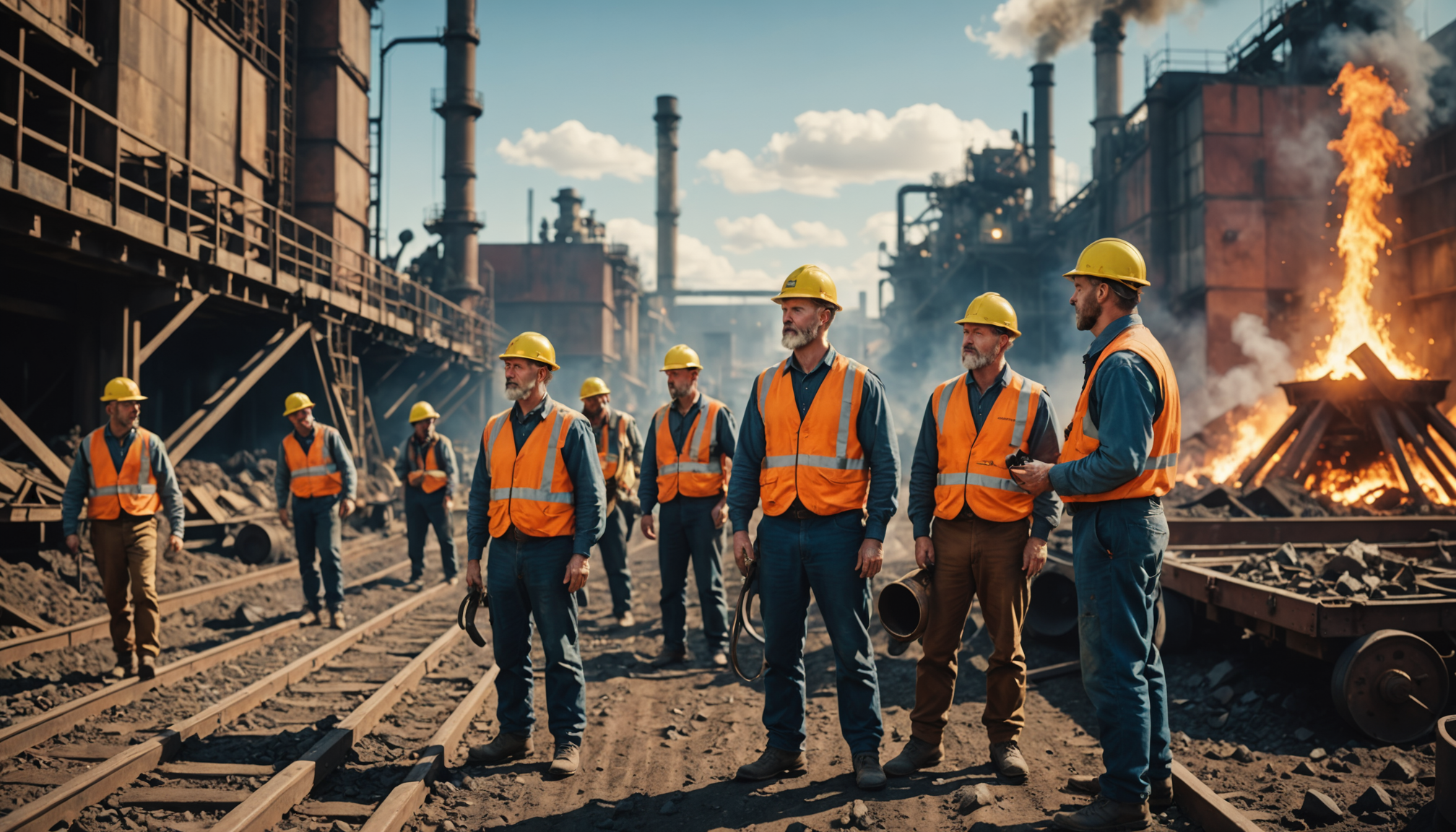
Australia’s Industrial Sector Faces Energy Crisis Amidst Sustainable Development Goals
Introduction
Australia’s major industrial companies are urgently appealing for government assistance as soaring energy prices threaten their viability. This situation presents a critical test for Prime Minister Anthony Albanese’s Labor government, particularly in balancing industrial growth with sustainable development objectives aligned with the United Nations Sustainable Development Goals (SDGs).
Energy Challenges and Industrial Impact
Several Australian metals smelters have reached a crisis point over the past year due to high energy costs and volatile commodity prices, putting thousands of jobs at risk. The predicament highlights challenges related to SDG 7 (Affordable and Clean Energy) and SDG 8 (Decent Work and Economic Growth).
- Mount Isa Copper Smelter Crisis
- UK-listed miner Glencore reported the Mount Isa copper smelter in Queensland as unviable due to unprecedented market conditions, high energy, gas, and labor costs, and a shortage of copper concentrates.
- Industry Minister Tim Ayres emphasized the strategic importance of the smelter for Australia’s sovereign capability and downstream industries.
- Tomago Aluminium Smelter Uncertainty
- Rio Tinto, the largest shareholder, faces uncertainty at the New South Wales Tomago aluminium smelter, which consumes about 10% of the state’s electricity.
- The New South Wales Labor government is considering intervention, potentially involving billions in public funds, to support the smelter during the energy transition.
- Other Industrial Concerns
- Rio Tinto has expressed concerns over a hydro-powered aluminium smelter in Tasmania.
- Sanjeev Gupta’s GFG Alliance’s manganese facility seeks bailout support.
- Commodities trader Trafigura suggested governments consider nationalizing struggling smelters to compete with China.
Government Response and Policy Considerations
The Albanese government has prioritized manufacturing revival and the energy transition, aligning with SDG 9 (Industry, Innovation, and Infrastructure) and SDG 13 (Climate Action). However, it faces complex decisions regarding support for energy-intensive industries and foreign ownership in strategic sectors.
- Manufacturing and Energy Transition
- Albanese’s administration promotes production credits for smelters shifting to renewable energy sources.
- The government aims to balance industrial productivity with environmental sustainability.
- National Security and Economic Sovereignty
- Closure of key smelters is viewed as a threat to Australia’s sovereign capabilities.
- Calls for government intervention emphasize safeguarding critical minerals and manufacturing sectors.
- Regulatory and Investment Environment
- Efforts to reduce regulatory “red and green tape” aim to stimulate private sector investment, supporting SDG 17 (Partnerships for the Goals).
- Provisional approval of a 45-year extension for Woodside Energy’s gas project reflects a pragmatic approach to energy security and economic growth.
Stakeholder Perspectives
- Economic and Industry Experts
- Economist Saul Eslake highlighted Labor’s focus on manufacturing but cautioned against bailing out unviable smelters that may hinder productivity improvements.
- Danielle Wood, chair of the Productivity Commission, stressed the need for revenue-neutral reforms to support economic stability.
- Business Community
- Business Council of Australia advocates for a national research and development strategy with tax incentives to boost investment.
- Australian Industry Group calls for convincing business leaders that government reforms align with private sector productivity goals.
- Industry leaders welcome steps to reduce regulatory barriers and increase certainty for investment.
Conclusion
The current industrial energy crisis in Australia underscores the critical intersection of economic growth, energy affordability, and environmental sustainability. The government’s response will significantly influence progress toward multiple Sustainable Development Goals, including:
- SDG 7: Ensuring access to affordable, reliable, sustainable, and modern energy.
- SDG 8: Promoting sustained, inclusive economic growth and decent work.
- SDG 9: Building resilient infrastructure and fostering innovation.
- SDG 13: Taking urgent action to combat climate change and its impacts.
- SDG 17: Strengthening partnerships to mobilize resources and support sustainable development.
Balancing industrial competitiveness with sustainable development remains a pivotal challenge for Australia’s government and industry stakeholders moving forward.
1. Sustainable Development Goals (SDGs) Addressed or Connected
- SDG 7: Affordable and Clean Energy
- The article discusses high energy prices impacting industrial operations and the transition from coal-fired power to renewable energy sources.
- SDG 8: Decent Work and Economic Growth
- Job risks in metals smelting and manufacturing sectors due to economic pressures are highlighted.
- Focus on boosting productivity and investment in the private sector.
- SDG 9: Industry, Innovation and Infrastructure
- Emphasis on manufacturing revival, industrial policy, and critical minerals processing industry.
- Calls for national research and development strategies and investment incentives.
- SDG 12: Responsible Consumption and Production
- Discussion on energy transition and reducing reliance on fossil fuels.
- SDG 13: Climate Action
- Transition from coal to renewable energy and environmental concerns related to gas projects.
- SDG 17: Partnerships for the Goals
- Government-business relations, summits to build consensus among stakeholders.
2. Specific Targets Under Those SDGs
- SDG 7: Affordable and Clean Energy
- Target 7.2: Increase substantially the share of renewable energy in the global energy mix.
- Target 7.a: Enhance international cooperation to facilitate access to clean energy research and technology.
- SDG 8: Decent Work and Economic Growth
- Target 8.2: Achieve higher levels of economic productivity through diversification, technological upgrading, and innovation.
- Target 8.5: Achieve full and productive employment and decent work for all women and men.
- SDG 9: Industry, Innovation and Infrastructure
- Target 9.2: Promote inclusive and sustainable industrialization and, by 2030, significantly raise industry’s share of employment and GDP.
- Target 9.5: Enhance scientific research, upgrade technological capabilities of industrial sectors.
- SDG 12: Responsible Consumption and Production
- Target 12.2: Achieve sustainable management and efficient use of natural resources.
- SDG 13: Climate Action
- Target 13.2: Integrate climate change measures into national policies, strategies, and planning.
- SDG 17: Partnerships for the Goals
- Target 17.16: Enhance the global partnership for sustainable development, complemented by multi-stakeholder partnerships.
3. Indicators Mentioned or Implied to Measure Progress
- Energy Prices and Consumption
- Electricity usage by smelters (e.g., Tomago aluminium smelter uses about 10% of NSW electricity) as an indicator of energy consumption patterns.
- Costs of energy (power bills) affecting industrial viability.
- Employment and Job Security
- Number of jobs at risk in metals smelting and manufacturing sectors.
- Employment rates in industrial sectors.
- Industrial Productivity and Investment
- Levels of private sector investment and productivity improvements.
- Research and development investment levels, including tax incentives.
- Renewable Energy Transition
- Production credits for smelters switching to renewable energy as a measure of transition progress.
- Extent of coal-fired power replacement by renewable sources.
- Environmental and Regulatory Measures
- Approval and regulation of energy projects (e.g., gas project extensions) reflecting policy integration of climate action.
- Reduction of red and green tape as a measure of regulatory efficiency.
- Stakeholder Engagement
- Summits and consensus-building events involving government, business, and unions as indicators of partnership effectiveness.
4. Table of SDGs, Targets, and Indicators
| SDGs | Targets | Indicators |
|---|---|---|
| SDG 7: Affordable and Clean Energy |
|
|
| SDG 8: Decent Work and Economic Growth |
|
|
| SDG 9: Industry, Innovation and Infrastructure |
|
|
| SDG 12: Responsible Consumption and Production |
|
|
| SDG 13: Climate Action |
|
|
| SDG 17: Partnerships for the Goals |
|
|
Source: ft.com







